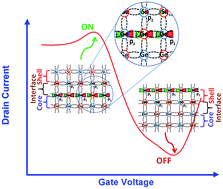Catching the electron in action in real space inside a Ge–Si core–shell nanowire transistor†
Abstract
Catching the electron in action in real space inside a semiconductor Ge–Si core–shell nanowire field effect transistor (FET), which has been demonstrated (J. Xiang, W. Lu, Y. Hu, Y. Wu, H. Yan and C. M. Lieber, Nature, 2006, 441, 489) to outperform the state-of-the-art metal oxide semiconductor FET, is central to gaining unfathomable access into the origin of its functionality. Here, using a quantum transport approach that does not make any assumptions on electronic structure, charge, and potential profile of the device, we unravel the most probable tunneling pathway for electrons in a Ge–Si core–shell nanowire FET with orbital level spatial resolution, which demonstrates gate bias induced decoupling of electron transport between the core and the shell region. Our calculation yields excellent transistor characteristics as noticed in the experiment. Upon increasing the gate bias beyond a threshold value, we observe a rapid drop in drain current resulting in a gate bias driven negative differential resistance behavior and switching in the sign of trans-conductance. We attribute this anomalous behavior in drain current to the gate bias induced modification of the carrier transport pathway from the Ge core to the Si shell region of the nanowire channel. A new experiment involving a four probe junction is proposed to confirm our prediction on gate bias induced decoupling.



 Please wait while we load your content...
Please wait while we load your content...